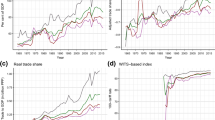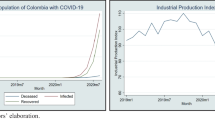Abstract
This study examines the effects of terms of trade and its volatility on economic growth for a sample of 94 developed and developing countries, using 5 year average annual data from 2004 to 2008. The cross country ordinary least square estimation results indicate significant positive effect of terms of trade on economic growth. Furthermore, volatility of terms of trade has significant positive effect on economic growth. To test the robustness of initial results, sensitivity analysis has been performed using different additional variables, sample size and various proxies of volatility variable. The initial results were found robust despite the inclusion of various variables in the basic model and use of various proxies for volatility of terms of trade.



Similar content being viewed by others
Notes
For detail study of such theories, see Salvatore (2004) pp. 33–37 and pp. 115–146.
These countries were Canada, France, Germany, Italy, Japan, UK, USA, Finland, Switzerland, Denmark, Netherland, India, Korea, Malaysia, Mexico and Srilanka.
The study uses data of 9 industrial countries and 31 developing countries.
They categorize the sample countries according to core and periphery by labor scarcity (measured by the 1913 real wage rate of unskilled urban male workers (purchasing-power-parity adjusted and relative to Britain) and level of development (development, measured by 1913 GDP per capita (in 1990 Geary-Khamis dollars) criteria.
For Australia from 1970:2–1997:2; for Canada (1970:2–1997:4); for New Zealand (1980:2–1997:2); for the United Kingdom (1970:2–1997:4); and for the United States (1973:2–1997:4).
The study includes 19 core and 16 periphery countries.
The core countries are the industrialized countries had rising terms of trade throughout the seven decades and the periphery had no rise and experience long run decline.
These countries were developing and small OECD economies.
The G-7 countries were Canada, France, Germany, Italy, Japan, United Kingdom and United States.
Blattman et al. (2003) has adopted the same method for measurement of volatility.
The web link of data source is http://data.worldbank.org/data-catalog/world-development-indicators.
To check the problem of heteroscedasticity, White heteroscedasticity test has been applied. Test results suggest that heteroscedasticity does not exist in both regression models.
Models with the inclusion of FE, INF, PE and HE variables have 88, 71, 81 and 93 countries respectively.
For 5 year moving average and 5 year moving standard deviation we used annual terms of trade from 2000 to 2008.
References
Adeniyi OM, Abiodun LN (2011) Health expenditure and Nigerian economic growth. Eur J Econ Finance Adm Sci (30):125–129
Arize A (1996) Cointegration test of a long-run relation between the trade balance and the terms of trade in sixteen countries. N Am J Econ Financ 7:203–215
Barro RJ (1996) Determinants of economic growth: a cross-country empirical study. NBER Working Paper 5698
Blattman C, Hwang J, Williamson JG (2003) The terms of trade and economic growth in the periphery 1870–1983. National Bureau Economic Research, Working Paper 9940
Bleaney M, Greenaway D (2001) The impact of terms of trade and real exchange rate volatility on investment and growth in Sub-Saharan Africa. J Dev Econ 65:491–500
Bouakez H, Kano T (2008) Terms of trade and current account fluctuations: the Harberger–Laursen–Metzler effect revisited. J Macroecon 30:260–281
Cashin P, McDermott CJ (2002a) The long-run behaviour of commodity prices: small trends and big variability. Int Mone’t Fund Staff Pap 49(2):175–199
Cashin P, McDermott CJ (2002b) Terms of trade shock and the current account: evidence from five industrial countries. Open Econ Rev 13:219–235
Edwards JA (2007) Dynamics of cross country growth/volatility relationship. Glob Econ J 7(2):1–18
Fatima N (2010) Analysis of terms of trade effect for Pakistan, Pakistan Institute of Development Economics. Working Paper 2010:59
Goel RK, Ram R (2001) Irreversibility of R&D investment and the adverse effect of uncertainty: evidence from the OECD countries. Econ Lett 71:287–291
Hadass YS, Williamson JG (2001) Terms of trade shocks and economic performance, 1870–1940: Prebisch and Singer revisited. National Bureau Economic Research, Working Paper 8188
Hamori S (2008) Trade balances and the terms of trade in G-7 countries: penal cointegration approach. Appl Econo Int Dev 8(2):13–22
Harberger AC (1950) Currency depreciation, income and the balance of trade. J Polit Econ 58(1):47–60
Laursen S, Metzler LA (1950) Flexible exchange rates and the theory of employment. Rev Econ Stat 32:281–299
Levine R, Renelt RD (1992) A sensitivity analysis of cross country growth regression. Am Econ Rev 82(4):942–963
Lutz M (1999) A general test of the Prebisch-Singer hypothesis. Rev Dev Econ 3(1):44–57
Mendoza EG (1997) Terms-of-trade uncertainty and economic growth. J Dev Econ 54:323–356
Misztal P (2010) The Harberger–Laursen–Metzler effect. Theory and practice in Poland. Rom Econ J XIII(38):129–146
Otto G (2003) Terms of trade shocks and the balance of trade: there is a Harberger–Laursen–Metzler effect. J Int Money Financ 22:155–184
Prebisch R (1950) The economic development of Latin American and its principal problems (Lake Success, NY: United Nations, Department of Economic Affairs). Reprinted in Economic Bulletin for Latin America 7(1962):1–22
Salvatore D (2004) International economics, 4th edn. McGraw Hill, New York
Singer HW (1950) The distribution of gains between investing and borrowing countries. Am Econ Rev 40:473–485
Stastny M, Zagler M (2007) Empirical evidence on growth and volatility. EUI Working Paper 2007/22
Tsen WH (2009) Terms-of-trade and trade balance: some empirical evidence of Asian economies. Int Trade J 23(4):422–457
Wong HT (2004) Terms of trade and economic growth in Malaysia. Labuan Bull Int Bus Financ 2(2):105–122
Wong HT (2010) Terms of trade and economic growth in Japan and Korea: an empirical analysis. Empir Econ 38:139–158
World Development Indicator (various years)
Web Link: http://data.worldbank.org/data-catalog/world-development-indicators
Yanikkaya H (2003) Trade openness and economic growth: a cross-country empirical investigation. J Dev Econ 72:57–89
Author information
Authors and Affiliations
Corresponding author
About this article
Cite this article
Jawaid, S.T., Waheed, A. Effects of Terms of Trade and its Volatility on Economic Growth: A Cross Country Empirical Investigation. Transit Stud Rev 18, 217–229 (2011). https://doi.org/10.1007/s11300-011-0201-7
Received:
Accepted:
Published:
Issue Date:
DOI: https://doi.org/10.1007/s11300-011-0201-7




